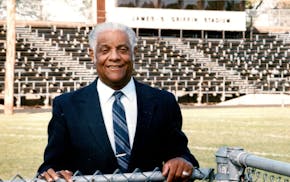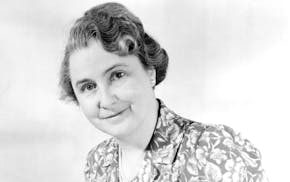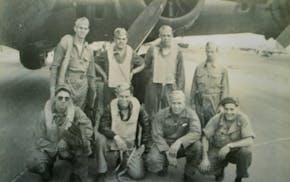Longtime Minneapolis developer Ray Harris' accomplishments are vast — even though the distance he's covered is short.
"I was born in the old Eitel Hospital in Loring Park and today I live in the Kenwood retirement community," he said. "So I've traveled about a mile in my 94 years."
Along the way, Harris became the driving force behind the Lake and Hennepin retail center formerly known as Calhoun Square; the site of Orchestra Hall; downtown housing, and even a dog park in Loring Park.
All that will get Harris enshrined in the Minnesota Real Estate Hall of Fame during a breakfast Nov. 15 at the Golden Valley Country Club.
You can learn more about Harris' life journey in the blog he began writing in his 90s, at therayharris.com. As he puts it, he's "graduated" from hospice and uses a wheelchair to get around.
"But above the waist," he said, "I'm still going 200 miles per hour."
Our recent conversation ranged from talk about his hero, Don Quixote, to his "derriere theory." Harris has collected books and art work about Quixote, Miguel de Cervantes' 400-year-old, windmill-tilting character.
"We both love chasing impossible dreams," said Harris, who built Greenway Gables townhouses in Loring Park in the 1970s when downtown housing was the last thing on most people's minds.
"What other people called problems, I called opportunities," he said. "People thought I was crazy when I invested in downtown housing. Now 60,000 people live downtown."
When members of the Dayton and Pillsbury families approached him about moving the Minneapolis Symphony Orchestra from Northrop Auditorium at the University of Minnesota to the aging downtown Lyceum Theater in the 1970s, Harris persuaded them to demolish the old theater on Nicollet Mall to make way for what became Orchestra Hall.
"Peoples' rear ends had grown bigger and we needed more ample seats, so we tore the Lyceum down," he said. "That's the derriere theory."
Ray's dad, Leo Harris, was a child of Polish Jews who immigrated to Minnesota in 1870. Leo ran a company that dredged Mississippi River locks and Minneapolis city lakes, and served on the Minneapolis Park Board from 1915 to 1918. Ray's mother, Eleanor, was an artist who had her work displayed around the country and served on the Walker Art Center board.
The second of three sons, Ray earned a degree from Stanford University and served in the U.S. Army. After getting into real estate, he began donating more than a quarter of his time pro bono to civic and charitable causes.
Perhaps his most intriguing legacy is his collection of nearly 500 matchbooks from the 1940s to 1960s advertising night clubs, hospitals, stores, banks, restaurants and hotels — many of which have disappeared. He keeps the collection in three large notebooks.
As a kid, Harris regularly headed to Memorial Stadium at the U during the Gophers' glory years under coach Bernie Bierman. "After the games, I went through the seats and started to pick up matchbooks," Harris said. "I've saved an absolutely fascinating history of Minneapolis and my matchbooks tell as much about the history of this town as old existing buildings."
There's one from the Mayflower Doughnut Shop at 805 Nicollet Av., which Harris said was across the street from where the Minneapolis Millers played. There's another with the words "Taken From Mayor Humphrey's Desk," dating back to Hubert's three years as Minneapolis mayor in the 1940s.
Although he's discarded most of the matchbooks he collected, he still has a favorite from football legend Bronko Nagurski's Pure Servicenter gas station in International Falls that advises: "BE SURE WITH PURE."
One of Ray and Alta Harris' four children, Sarah Harris, said they plan to discuss donating the matchbook collection to the Hennepin County Library. "They need a home," she said.
The matchbooks "offer an encyclopedic panorama and colorful kaleidoscopic view of daily life in the Twin Cities of that era," according to Harris' longtime friend Merrill Busch.
A 1989 Star Tribune profile of Harris discussed his love for White Castle burgers and how, at the height of his success, he drove an old Ford Escort. The story quoted former Mayor R.T. Rybak, who was then development director of the Minneapolis Downtown Council.
"There are a lot of developers around who seem to be more gloss than substance," Rybak said. "That's not Harris' style. He is not the smooth-talking, pat-you-on-the-back kind of guy. He's a hard-nosed, hard-working, opinionated type who will keep banging into brick walls until he gets through them."
Harris said those who were skeptical of his plans for Uptown retail or downtown housing only fueled him.
"People would tell me: 'That's never going to happen, no way,' " Harris said. "And that just turned me on."
Curt Brown's tales about Minnesota's history appear every other Sunday. Readers can send him ideas and suggestions at mnhistory@startribune.com. His latest book looks at 1918 Minnesota, when flu, war and fires converged: strib.mn/MN1918.

Minnesota History: Ad man turned Paul Bunyan into a folklore icon

Minnesota History: James Griffin used persistence to blaze a trail for St. Paul's Black police officers

Minnesota History: For Granite Falls doctor who tested thousands of kids for TB, new recognition is long overdue

Minnesota History: A New Ulm baker wearing a blanket fell to friendly fire in the U.S.-Dakota War


